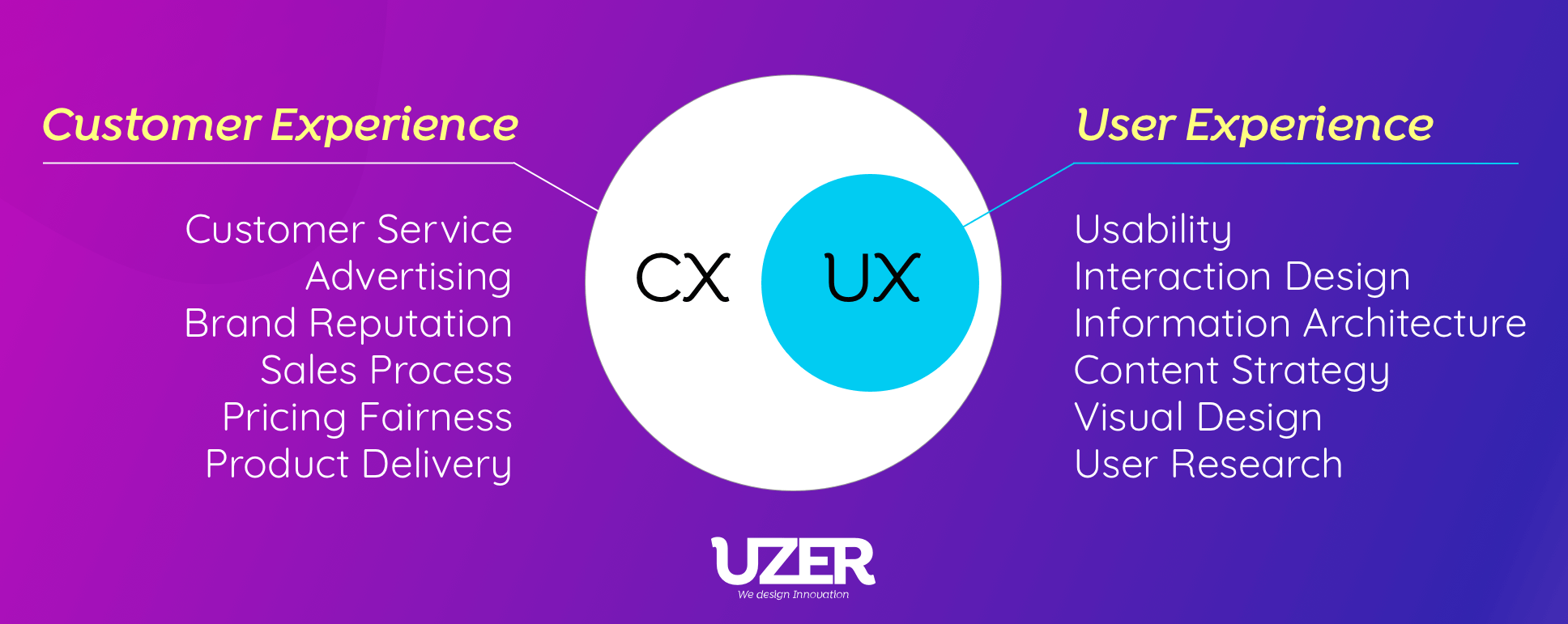We are in the digital age, there are many technological terms that have appeared in recent years to be part of our day to day due to their high relevance in business and that become common concepts such as Big Data, Artificial Intelligence (AI), User experience (UX), User Interface (UI), Agile, Design Thinking, etc. most of these terms are techniques or methodologies that a company like UZER.co must quickly adopt to be part of its services. One of these terms is the CX or Customer Experience and why many customers have asked us about their difference with User experience (UX). Although these two concepts are originally synonymous, in practice, Customer Experience (CX) and User Experience (UX) have been differentiating around how they are approached by product design or innovation teams. When we talk about customer experience (CX), we talk in general about all the experiences a person has when interacting with a brand, both before, during, and after a business relationship; it begins at the same time that the person has knowledge or notion of the existence of it and is nourished by all the inputs that he receives from the company in the form of advertising, comments from other people, experiences of intercommunication with commercial agents, customer service, with the product, etc. In general, CX is the experience across all channels and media generated by a company with a person. The user experience (UX), originally a term that was used to mean the same as CX, however, within the experience, mainly in digital products, one of the factors that had the greatest impact on business conversion, customer satisfaction and brand image was specifically the autonomous experience that a user has with the product when they have it in their hands through their mobile device or through the screen of a computer. That is, the experience a user lives when using an app or site, whether it’s web, native for mobile, or through other human interaction devices such as digital kiosks, augmented reality devices, TVs, or any format that usually presents a screen to interact with the user. And that high relevance of this process has become more popular and that’s why many times when you talk about the design of that experience the term UX is used more commonly. In that context, UX is the complete experience when using a product, system, or service. These include user perceptions in aspects such as utility, ease of use and efficiency, as well as aspects that define the person-to-computer system relationship and product ownership. Therefore, that definition of UX has become one of the most important elements for the entire CX to be successful and can be a great support for user loyalty. In general, it seems that the vision of experience is broader when we refer to CX, as it addresses all channels and points of contact with people. However, when we think about the public’s vision of who is considered, it can be more impactful in UX. This is because users of a service are older than consumers (or who actually transacts) in it.

It is true that consumers are the ones who buy the products, however, long-term success depends on all users and that positive usage experiences lead to more uses and consequently more purchases or leads. Being the UX aimed at a wider audience and a strategic audience (potential future consumers), creates a space to innovate and think about how to create something new or how to surprise and create memorable experiences, however, you can’t let go that what we might call a good UX should be accompanied by a good customer experience (CX) on all channels beyond the screens, such as the telephone or face-to-face customer service channel, as well as all elements of any face-to-face experience that often involves the provision of the service itself, such as an airline, for example. In terms of innovation, which is when the most important is given to the terms UX and CX, it is determined that the focus should never be only on fixing current problems detected, which is known as incremental innovation. The focus should be radical innovation, i.e. questioning support, technology capabilities and creating novelties from scratch. In conclusion the CX and UX are different but should not be taken as separate parts of a company. That is, an appropriate design of the User Experience is a great support to improve the Customer Experience, it adds value to you by understanding the context and needs of people offering better solutions. Finally, both UX and CX must be customer-centric and prioritize the personal user experience. At UZER we are experts in CX and UX design for digital products and services, do you have a project in mind? Let’s talk, contact us here .




